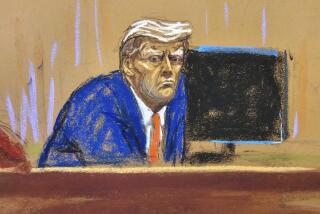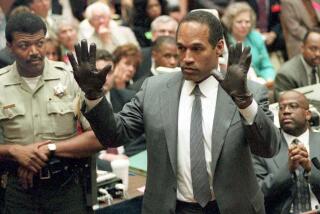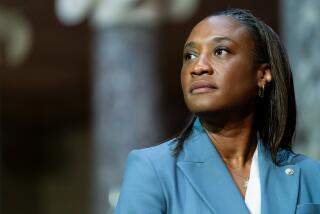SENATE’S BEAUTY IN THE EYE OF A TV CAMERA : By JUDITH MICHAELSON, <i> Times Staff Writer</i>
WASHINGTON — About to vote on the matter of retaining television coverage in the U.S. Senate, Sen. Ernest F. (Fritz) Hollings (D-S.C.)--snow-white-haired, trim, telegenic teeth--emerged from one of the private Capitol elevators Tuesday night, tapped an aide on the back and said loud enough to be overheard: “I’m going to be on Tee-Vee! Yessirree!”
Although Hollings may have sounded like an ordinary citizen encountering a fleeting instant of fame, the remark was more in bite than delight. He was, after all, one of the relatively small band of 21 senators voting against live gavel-to-gavel coverage.
Still, the thrill--and power--of being “on Tee-Vee” must have been felt by the overwhelming majority. Seventy-eight senators opted to retain TV cameras and radio mikes in the Senate on a permanent basis, following its six-week test of televised sessions.
As minority Leader Robert Byrd (D-W.Va.) noted in February, when discussion of the subject blossomed: “The Senate (is) fast becoming the invisible half of Congress, and . . . we cannot hold our own with the White House and the House of Representatives when it comes to news coverage of the important issues of the day.”
On the day the Senate voted for live TV and radio coverage--seven years and four months after the House--the members generally heeded an informal memo on dress and behavior that had been made available by the Senate Radio-Television Recording Studio, which is in charge of feeding the signal to C-SPAN II, the Cable Satellite Public Affairs Network.
“Light-colored clothing is best for television,” the memo labeled “Hints and Clues” began. “Blue shirts and red ties. Dark clothing is not as good as light-colored clothing, but dark is not unacceptable on camera.
“Striped seersucker suits and striped shirts are really bad. The shirt and suit will appear to be running.
“White shirts cause glare. They are not as good as blue shirts but are acceptable.”
The chamber was rather well represented by blue shirts and red ties Tuesday, although most senators stuck to their dark-colored suits in shades of navy and charcoal gray.
California’s two Senators, Democrat Alan Cranston and Republican Pete Wilson, who voted for televising the Senate, each wore blue shirts, red ties and light gray suits.
Sen. Nancy Landon Kassebaum (R-Kan.), although she cast a no vote, wore a red (with simple white print) dress. “I don’t usually go this bright,” allowed Kassebaum, one of the Senate’s two women. She worried that television would “bore” the public, that “the more we have of TV, the less people will watch.”
“Hints and Clues” also advised senators to “handle the microphones gently. Rubbing the mike against hands, clothes or papers results in a frying noise. Coughing, sneezing or laughing into the mike results in a blasting noise.”
There appeared to be little frying or blasting Tuesday.
Until television’s trial in the Senate chamber, which began on a closed-circuit basis in May and went to the public in June, the recording office had simply serviced the making of audiotapes and videotapes that senators send to stations back home. Trial radio broadcasting began in March.
In its basement recesses, the Senate now also has a video control room of 13 video engineers, directed by Donna Stiles, formerly of the Voice of America, who monitors six cameras situated in the galleries. “I hope we get more cameras,” she said.
During the day, viewers might have heard Sens. Cranston, Edward M. Kennedy (D-Mass.) and Lowell P. Weicker Jr. (R-Conn.) speak out in favor of the strongest possible sanctions against South Africa; or Sen. Claiborne Pell (D-R.I.) pay tribute to Averell Harriman, whose funeral was held in New York Tuesday, or see Sen. Alan J. Dixon (D-Ill.) discuss the plight of Soviet Jews.
But for much of the day, at least when business was being conducted on the floor, the senators dealt with the scheduled issue of television.
In between there were no fewer than a dozen quorum calls lasting from a few minutes to nearly half an hour while senators worked behind the scenes, and the television screen bore the message, “The Senate is conducting a quorum call and will consider Senate Televison presently.”
Those in favor of television argued the seemingly obvious--what Majority Leader Robert Dole (R-Kan.) called “building an electronic bridge to the American people”--that televised proceedings would make for a better-informed public.
“We all recognize the great value of a fully informed public,” asserted Sen. Wendell Ford (D-Ky.), adding: “Like life itself, television broadcasting is not perfect. . . . “
“Television,” said Sen. Daniel J. Evans (R-Wash.) just before the afternoon session began, “is like a window on the Senate.”
The flashier language belonged to the opposition.
“Television,” argued Sen. William Proxmire (D-Wisc.) as the afternoon debate got under way, “is the Che Guevara of modern society.” He added that television, which “can be powerfully bad as well as powerfully good,” will “reward the demagogue.” Sen. Russell Long (D-La.) worried that the camera would intrude on the Senate as the “citadel of ideas” and Sen. Mark Hatfield (R-Ore.) feared “prime-time programming.”
Other senators maintained that television would show up the demagogues as well as the grandstanders. “People who watch television know posturing when they see it,” said Byrd. “You can’t fool the camera,” said Wilson in an interview, adding that he hoped that television would help “streamline” Senate procedures.
Others, who spoke on behalf of television, thought that one of their better arguments was that television had not made much of a difference, that even under the glare of the lights the Senate appeared to be able to transact business as usual.
With the vote a foregone conclusion, the Senate hardly needed the 12 hours of debate allotted, and during much of the session the floor was virtually empty--something viewers do not see.
In late afternoon, even in the Senate press gallery just outside the floor, the 25-inch color TV was tuned to public-television coverage of the Senate Judiciary Committee hearings on the confirmation of Justice William H. Rehnquist as Chief Justice of the Supreme Court.
Most senators noted that television has really not changed them. But Sen. Daniel P. Moynihan (D-N.Y.) indicated that some senators have become a little more self-conscious of physical or behavioral attributes. “My staff has told me I speak like a metronome, swinging from left to right,” he said smiling, while noting that other senators have been told by their staffs that “bald spots show or they look down at their shoes.”
The Senate itself has undergone a bit of a face lift. Ralph Griffith, director of the Senate’s recording studio, told C-SPAN recently that the chamber has “already changed just a little.” The flagpole, he said, has been shortened six inches, and a new curtain was put in behind the presiding officer. “The old curtain was a dark blue, and it was so blue it was black (on TV).”
Longtime observers note the lighting in the chamber is now better, and that the brightening of the Senate took place gradually, probably so as not to arouse discontent.
More sprucing up is under way. A mustard-colored back wall, which Dole characterized as “split-pea soup” and which other senators have said looks like a “bus terminal,” will likely be repainted. And Charles McC. Mathias Jr. (R-Md.), chairman of the Rules Committee, who led the debate for television, said that while eight TV cameras are “desirable,” the committee does not want to exceed budget.
A compromise of sorts was reached. He said seven cameras should give “an adequate picture.”
More to Read
Get the L.A. Times Politics newsletter
Deeply reported insights into legislation, politics and policy from Sacramento, Washington and beyond. In your inbox three times per week.
You may occasionally receive promotional content from the Los Angeles Times.










